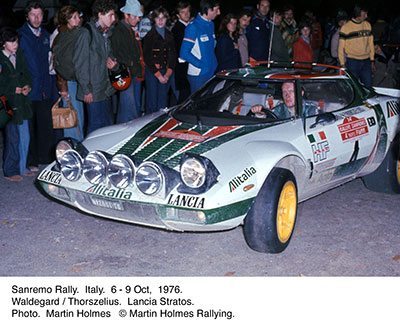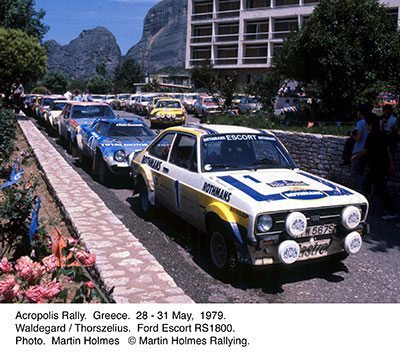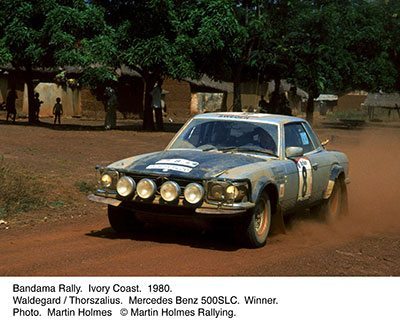In 2002, Rally XS magazine voted Sweden’s Bjorn Waldegard the best rally driver ever, and with good reason. Waldegard, the winner of 16 World Championship events, has driven everything from Volkswagen Beetles to Group A Celica GT-Fours and has won on every surface and against the best opposition.
His position as number one, while surprising many, can not be questioned.
“He won the Swedish as long ago as ’68, and his last world championship win came on the Safari in ’90,” Rally XS trumpets. “Spanning four decades of the top flight is no mean feat. Doing it while remaining competitive makes Bjorn our top choice,” it concluded.
Peter Whitten spent an hour with the 1979 World Champion the day before he contested the 2002 Dunlop Classic Rally in Otago, New Zealand last month.
Waldegard’s interest in rallying began at a very young age. His father competed at a low level and used to take the seven or eight year old Bjorn out all night to watch the local Swedish rallies. It was a bug that stuck and after buying a Volkswagen Beetle in 1962 (a common occurrence in Sweden as VW had a national team), his career began.
While idolising drivers of the ilk of Bengt Soderstrom, Waldegard showed immediate talent and by the time he purchased his second VW, he was already getting his cars at a reduced price.
Then Porsche hit the scene with their impressive 911, and it was in the popular German sportscar (supplied by the Swedish importer) that Waldegard won the 1967 and ’68 Swedish Championships.
A lot of pressure from the Swedish importer to the German team in Stuttgart saw him get a third car for the Monte Carlo Rally in 1969, and although he was an unknown outside Sweden and got no payment, he won the rally.
“I really didn’t know what to expect when I got the drive,” Waldegard remembers. “It was just a dream to be able to drive for the Porsche factory. Vic Elford and Pauli Toivonen (Henri’s father) were my main opposition and I just followed their speed and I beat them. “I remember thinking that the snowy stages were the ones I had to win, and I did win them quite easily. But at one point there was a young guy in an Escort only 30 seconds behind me. Hannu Mikkola, who the hell is he? After that we became good friends, drove for Ford and Mercedes together and our careers followed each other.”
“I remember thinking that the snowy stages were the ones I had to win, and I did win them quite easily. But at one point there was a young guy in an Escort only 30 seconds behind me. Hannu Mikkola, who the hell is he? After that we became good friends, drove for Ford and Mercedes together and our careers followed each other.”
OVERNIGHT SENSATION
Overnight Waldegard was a sensation and despite the European journalists not knowing who he was or how to spell his name, he’d gone from being an anonymous Swedish farmer’s son to being a star.
Any thoughts of being a farmer himself were quickly thrown out the window as he embarked on a 25 year career as a professional rally driver. Although he contested a few tarmac races, including the famous Targa Florio in 1970 in a Porsche 908 Sypder, it was something he didn’t enjoy.
“I didn’t like it too much, but you know, young and crazy, you took every chance possible to drive anything that had a steering wheel. But what changed my thinking completely was that I was invited to drive Le Mans in a Porsche 917 and I was ready to go when the team boss called and said that they had sold the third car to an Englishman named John Wolf.
“He then went and crashed on the main straight and killed himself, in my car. Then I thought, why should I gamble with my life when I love rallysport so much and am not sure about racing?”
SCANDINAVIAN SUCCESS The other top Swedish rally driver of that era was Stig Blomqvist. Three years younger than Waldegard, he reckons Stig stayed in the Swedish Championship for too long before eventually taking his chance at the top level.
The other top Swedish rally driver of that era was Stig Blomqvist. Three years younger than Waldegard, he reckons Stig stayed in the Swedish Championship for too long before eventually taking his chance at the top level.
Waldegard was driving for Porsche and took his chance on the international scene, but Blomqvist was contracted to Saab and didn’t make his mark outside Sweden until the early 1980s, with Audi.
But while Scandinavian drivers were the pacesetters in the 60s, 70s and 80s, he believes that the times have well and truly changed. South European drivers from countries like Spain and Italy are now doing well, but back in his day, Waldegard believes it was a bit of a mind-set that only drivers from Scandinavia could make the grade.
“When I was at the top, team managers would ask me if there was anyone else in Sweden who was fast, and I recommended Kenneth Eriksson, but now we are much behind in Sweden and the Finns seem to produce someone new every year. Sweden has many talented young drivers, but they don’t seem to present themselves as well as the Finns.”
Waldegard only won the World Championship for Drivers once, the year it was introduced in 1979. But his performances during the 70s in cars like the Lancia Stratos and the Ford Escort could well have seen him win the title many more times. Is this something that saddens him?
“You’re right. Maybe I wouldn’t have won it four or five times as you say, but certainly maybe two or three. But I’m very proud of what I achieved. To be able to have your hobby as a job for so long has been very special.”
Never one who’s had the mentality that he’s better than anyone else, Waldegard reckons it doesn’t matter if he’s won one title or three, saying he’s had a fantastic life and done a good job.
“That’s enough for me,” he says. “But of course being picked as number one in the recent RallyXS poll was a great honour. It was a surprise in a way, but because it was picked by professional journalists who have been around the sport for many years and it was done properly, I thought it was fantastic.”
Waldegard was an extremely versatile driver, a man who could win anywhere in any car – something drivers of the day like Sandro Munari could not do. Munari would only win on tarmac.
But despite the claim, he believes it was more a case of doing things seriously and committing himself 100%, rather than having more talent than the next guy.
“Events like the Safari and the Monte needed totally different preparations. If you were prepared to do that and learn all the time it was possible. I had to adapt my Swedish mentality to drive for an Italian team (Lancia), and if I wasn’t prepared to do that, it wouldn’t have worked. I alone couldn’t tell 50 Italians that what they were doing was wrong!”
FAVOURITE EVENT Because of his success, the Safari Rally will always be Waldegard’s favourite. His results helped lift Toyota’s sales and profile to what it is today and he sees his involvement in that success as one of the lasting memories from his career.
Because of his success, the Safari Rally will always be Waldegard’s favourite. His results helped lift Toyota’s sales and profile to what it is today and he sees his involvement in that success as one of the lasting memories from his career.
Even today he is treated like a celebrity in Kenya. Earlier this year he was in Kenya working with Thomas Radstrom and the Citroen team for their assault on this year’s Safari Rally. Arriving at customs in Nairobi, Waldegard handed over his passport: “Ah, welcome home, Mr Waldegard” the customs official said.
The Safari may have been his favourite event, but the Sanremo Rally of 1976 will go down as one of his best drives. Four seconds ahead of local hero Munari going into the final stage, Lancia boss Cesare Fiorio held Waldegard at the start line for four seconds so that the two Stratos drivers would start the final stage equal.
“It was in the early days of team orders and I just had to accept it,” he remembers. “Cesare Fiorio was a brave man because we both could have crashed. Waiting on the start line I decided to go for it, even though I thought I had no chance and that Munari would win on home soil, but I went for it and it was a fantastic feeling to beat him.”
Team orders still plays a part in the sport today, but for Waldegard, it’s all part of the sport. “If you look at bicycle racing they have five riders in a team who are working to support one rider to victory, so rallying is no different. If you drive for a team who are spending a fortune, you just have to accept it.”
That famous victory was his last drive in a Stratos. Ford called after the event offering a program in the Mk2 Escort, and Waldegard switched teams straight away.
The Stratos was a hard car to drive and there were not many drivers who mastered it (Waldegard being one of them). It was a car that needed to be driven aggressively, otherwise it would not be fast. Despite being rear engined like the Porsches he had driven earlier, it wasn’t as easy to drive. But despite this, Waldegard says it was a “fantastic” car.
So the move to the Escort was a nice change. With a traditional solid rear axle and leaf springs it was easy to drive and was run by a professional team.
“It was the best move of my career – fantastic years in my life. It was the toughest team there was and the rivalry was intense – a bit like Peugeot today. All the top drivers were in the one team, myself, Hannu and Ari Vatanen.”
Waldegard won the 1979 World title using both the Escort and a Mercedes, a car that he drove on events not contested by the factory Ford team.
“Mercedes took Hannu and I to Stuttgart to talk and we had no idea what they wanted,” he recalls. “When they said they wanted to go rallying we thought they had a small car in a garage somewhere that they would use, but they said they would use the 500 SLC.
“Hannu and I knew that it would be fun and we would get some good money, but it could not be a proper rally car. It was a strange and different feeling to go to a big company like Mercedes and we got some good results as well (3rd and 6th in New Zealand and 1st and 2nd in the Ivory Coast Rally).
“Then they said they wanted to go to the 1000 Lakes Rally in Finland, but we said ‘No, the car is too big’. So they stopped!”
TOYOTA AND BEYOND
Following that Waldegard went to Toyota, but good friend Mikkkola joined the unknown Audi team.
“Hannu was invited to Ingolstadt to drive an Audi. In those days Audis were for people who wore hats, but Hannu came back and said it was something incredible – a car with 4WD. He’d tried the car in a muddy field and he said the traction was unbelievable.
“He took the gamble as he had nothing with Ford, and I went to Toyota, but Audi was the one. I was disappointed that I wasn’t at Audi with him!”
Waldegard, though, knew that he had a good contract with Toyota and knew that they had a 4WD car coming, although it took five years to arrive. These were the Group B days and with the new Audi dominating the European ‘sprint’ events, Toyota concentrated on the African rallies. The two-wheel drive Celica was ideally suited to the rugged events in Kenya and the Ivory Coast.
His ten years with the team were rewarding for many reasons. It was a small team when he joined and he saw and helped them go from strength to strength.
“I did all the testing for the first 4WD Celica, but I was getting older by then and knew my time in the sport was limited. I had to accept that I had done a good job for the next generation – the young guys like Kankkunen and Sainz who had come into the team to beat me!”
But the World Championship career of Bjorn Waldegard ended with Lancia, not with Toyota. Toyota couldn’t decide if they would run two or three cars in the Safari Rally in 1992. Waldegard had already started to plan for his future after rallying and had been looking into Rally Raid events, so when Lancia called and offered good money for a one-off drive in a Delta, he jumped at the chance.
During practice for the event he “stupidly” turned into the grass and hit a tree stump, breaking his arm in many places after the steering wheel twisted. A lengthy operation in Nairobi hospital saw him receive many stitches (he still bears the scars today) in what was his only major injury as a top line driver.
“We started the rally with a tractor knob on the steering wheel so I could steer properly, and we were third about half way through the rally. But at a quick petrol stop that the team tried to perform in too much of a rush, fuel was spilt on the hot brake disc and the car went up in flames, ending his WRC career on a sour note.
His interest in Rally Raid events had been sparked by Ari Vatanen’s success with Peugeot and Citroen, and when Jean Todt offered him a drive he jumped at the chance.
“It was not about extreme speed, it was all about tactics and planning. But I never found it very interesting – they were very boring days of 500-600km through the desert on very bad roads or no roads at all. I asked myself why I was doing it.”
The straw that broke the camel’s back was the Paris-Moscow-Peking event in 1992. “Horrible,” is how he explains it. “Every day I asked myself what the hell I was doing. I decided during that event, even if I changed my mind a week later, that I would stop rallying. And I did.”
In Part 2 of our Bjorn Waldegard interview from 2002, the 1979 World Champion talks about leaving the sport, the changes rallying has undergone, his best drivers, biggest crash, and his favourite rally car. Don’t miss it.



